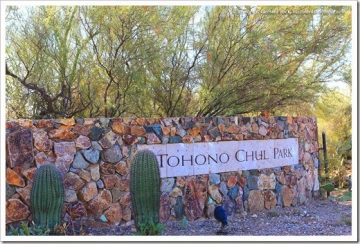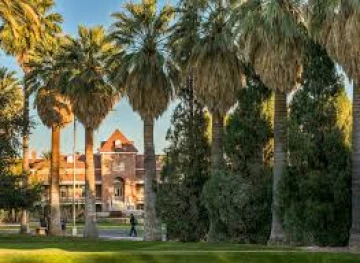
Trees can play a significant role in mitigating and adapting to global climate change, especially in urban environments. As such, urban greening initiatives are emerging at the forefront of community strategies for a changing climate. However, anticipated increases in global temperature will subject plants to temperatures never experienced before. As such, it is increasingly important to evaluate tree climate adaptation to ensure they are selected based on potential to survive and thrive in both the current and projected future climate. This project in partnership with Tohono Chul Park sought to evaluate the climate risk of tree species growing in our collections.
The University of Arizona Campus Arboretum and the Tohono Chul Park, are living collections of arid-adapted trees, situated within an urban center in the Sonoran Desert. These gardens provide a wide array of tree species to evaluate for potential performance in projected climate scenarios. With the 2017 release of the Global Tree Search, a database of 60,000 known tree species observed globally, and the subsequent development of the Climate Assessment Tool by Botanic Gardens Conservation International (BGCI) in 2022, we determined to evaluate climate ratings of 474 species in our collections under current and future predicted climate scenarios for Tucson, AZ including: “Current Climate” (based on climate data from 2020) assuming a mean annual temperature (MAT) of 21°C, an “Emissions Limited” (EL) climate change scenario (SSP2/RCP4.5), assuming a MAT of 23.6°C, and a “Business as Usual” (BU) climate change scenario (SSP3/RCP7.0), assuming a MAT of 26.5°C. The EL and BU scenarios are based on models developed by the Intergovernmental Panel on Climate Change (IPCC).

By comparing the taxa in two local arborescent plant collections with global observations of those species in regions around the world with mean annual temperature (MAT) equal to that in Tucson currently, and in predicted EL and BU scenarios for Tucson, we generated an initial list of species with potential to be climate-adapted. We further refined the list to select only species known to survive in climates with specific MATs with less than 500 mm of precipitation, as this is a constraint dictated by the Campus Arboretum’s collection policy. The initial results highlight species in two Tucson tree collections which have the greatest promise for performing well within Tucson’s current/future mean annual temperature. The analysis of the tree species with potential to endure the MAT of Tucson currently and into the future reflects an overall decline in the collection’s biodiversity with rising temperatures unless additional irrigation is provided or unless more heat adapted species are identified and planted. A subset of the species analyzed were identified with potential to perform better in warmer climate scenarios including one species with potential to survive in all three climate scenarios. These findings inform curation decisions and sustainability of both arboreta collections and may be relevant for tree planting recommendations in the surrounding community. Before ranking and recommending species for production and planting, we will further refine the list of adapted species based on known temperature (high and low) thresholds and based on input of urban forestry, and nursery practitioners. Future work will also include evaluation of tree species not before grown in Tucson based on high and low temperature thresholds and irrigation needs less than 500mm annually.
- Read the Full Report
- View the Research Poster
- Find the Complete List of Species Ready for the Tucson MAT under 3 Climate Scenarios. Also available as a .PDF file.
About Lenny

Leonardo ("Lenny") Sciulli graduated with a B.S. degree in Plant Sciences, from the College of Agriculture, Life and Environmental Sciences in May 2024. During his time at the University of Arizona, Lenny worked for the Campus Arboretum as an intern and student worker. His projects included developing a tour of the Mark Dimmitt Desert Plant Conservatory, hosting public tours of this protected collection, producing interactive (QR-coded) signage for more than 75 potted specimens and linking those signs to web content he helped research. He also conducted climate risk assessment of the trees on the main campus and on the grounds of the Tohono Chul gardens. Additionally, he assisted with many landscape installation projects, special events and participated in the work of other student service-learning projects.

